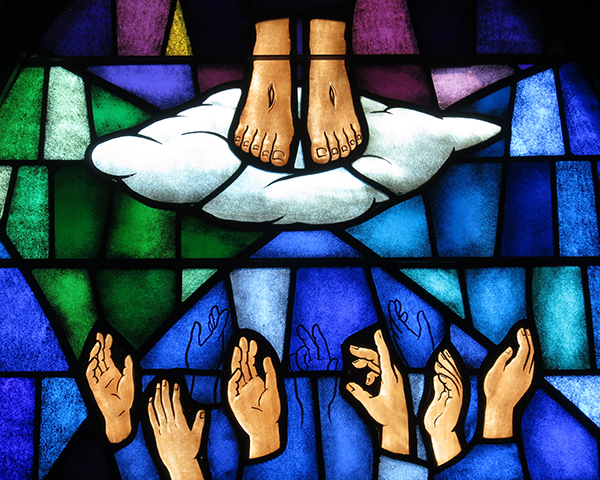By Mary Paul
From her column Dwelling with God
Haga clic aquí para ver esto en español
 I enjoy wandering around cathedrals. The different depictions of the scriptural narrative in stained glass, mosaics, carvings, and paintings help me to ponder anew God’s actions with us and for us. During one of these wonderings and contemplations, I looked up and was a bit startled by the carving above my head that showed two dangling bare feet from underneath a cloud. Initially I found this comical, but it didn’t take long to locate the story as the Ascension of Christ. My reaction and interest have stayed with me following this awakening of sorts. I found myself in visits to cathedrals, churches, and chapels taking note of how they represent the ascension. Crowds are depicted in various sizes. Jesus is sometimes almost lost in the heavens or barely off the ground. The onlookers in the scene seem to have a mixture of adoration and confusion. The shoes or sandals of Jesus are either flung to the side or placed neatly near what would have been his last grounded place of standing. But in all the ascension depictions, Jesus is barefooted.
I enjoy wandering around cathedrals. The different depictions of the scriptural narrative in stained glass, mosaics, carvings, and paintings help me to ponder anew God’s actions with us and for us. During one of these wonderings and contemplations, I looked up and was a bit startled by the carving above my head that showed two dangling bare feet from underneath a cloud. Initially I found this comical, but it didn’t take long to locate the story as the Ascension of Christ. My reaction and interest have stayed with me following this awakening of sorts. I found myself in visits to cathedrals, churches, and chapels taking note of how they represent the ascension. Crowds are depicted in various sizes. Jesus is sometimes almost lost in the heavens or barely off the ground. The onlookers in the scene seem to have a mixture of adoration and confusion. The shoes or sandals of Jesus are either flung to the side or placed neatly near what would have been his last grounded place of standing. But in all the ascension depictions, Jesus is barefooted.
In the 40 days of Jesus’ post resurrection appearances, he often called the witnesses to note, by touch or sight, the wounds on his body. There was something in that insistent invitation that calls us to pay attention to this embodied resurrection. These wounds help us to consider more deeply how this resurrection is not a resuscitation that returns Jesus to a pre-suffering, pre-wounded state. Rather, Jesus guides us to know an eternal life through wounds and death to a new kingdom come. The embodied Jesus who is raised to the right hand of the Father is the one who reigns forever. It is this Jesus under whose feet God placed all things (Eph. 1:22).
The wounds and bare feet call us to hear all the language of power referenced in the ascension story in a particular nuanced cruciform way. This is not the power of violence, domination, force, or hate. This is the power of sacrificial love, service, and mercy. This is a power defined by the cross. This is a power that gives witness to the fearless way we can live in the face of all we might perceive as threatening to our lives. Violence, domination, control, and hate have done their worst, but Christ’s sacrificial love, service, and mercy not only survive but reign. All who trust in Christ, though they die, will be lifted (with their own wounds and bare feet) into life in all its abundance. Jesus is not a superhero but a supra hero—one who is above and beyond the fight. Jesus does not combat violence with violence but with grace, love, and good news for all people.
I confess, that like the disciples at the ascension, I look to Jesus with adoration and befuddlement. I do not fully grasp the way of the wounded barefooted Christ who reigns. I am tempted to feel the fright of the powers and principalities and in turn respond in the way of this world. In all this reactivity I find the life, death, resurrection, and ascension of Jesus a call to pause. I breathe deeply a confession of “I believe, help my unbelief” (Mk. 9:24). My prayer is that my belief in the ascended reigning Christ, would settle into my bones, my soul, my actions and reactions. I pray I might so receive the good news of Christ’s reign that I might live a barefooted life.
This barefooted life represents a level of trust in God’s work of salvation for me, those I love, and those I find hard to love. The barefooted ascension reminds me of the glorious joy and abandoned trust as the Son is lifted into the full embrace of the Trinity. The barefooted life calls me to not take myself so seriously but walk lightly and faithfully in response to the Spirit. For in Christ, we have a glorious inheritance, and we do not need to be afraid (Eph. 1:18-23).
Dr. Mary Rearick Paul, D.Min., is a minister and vice president of student life and formation at Point Loma Nazarene University.
